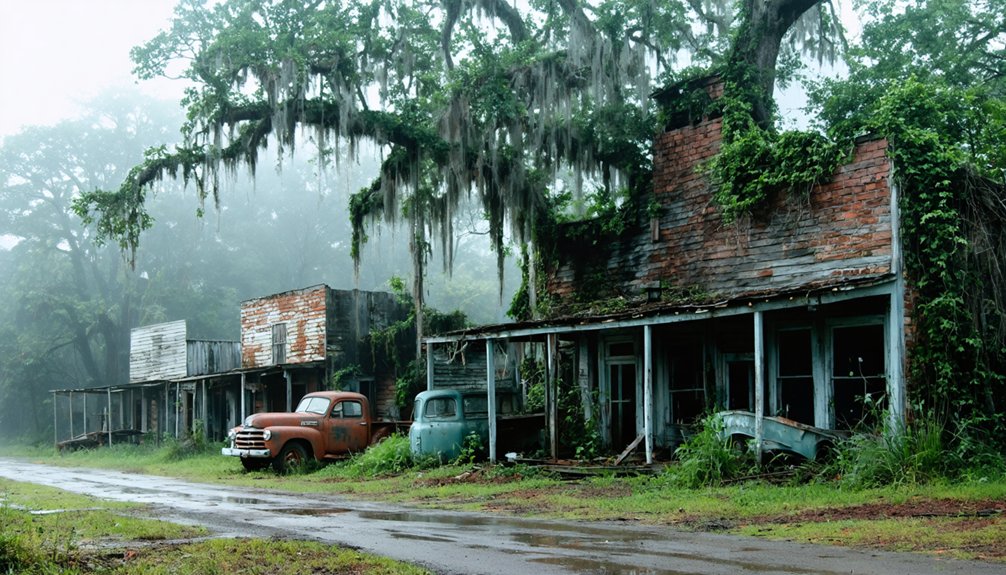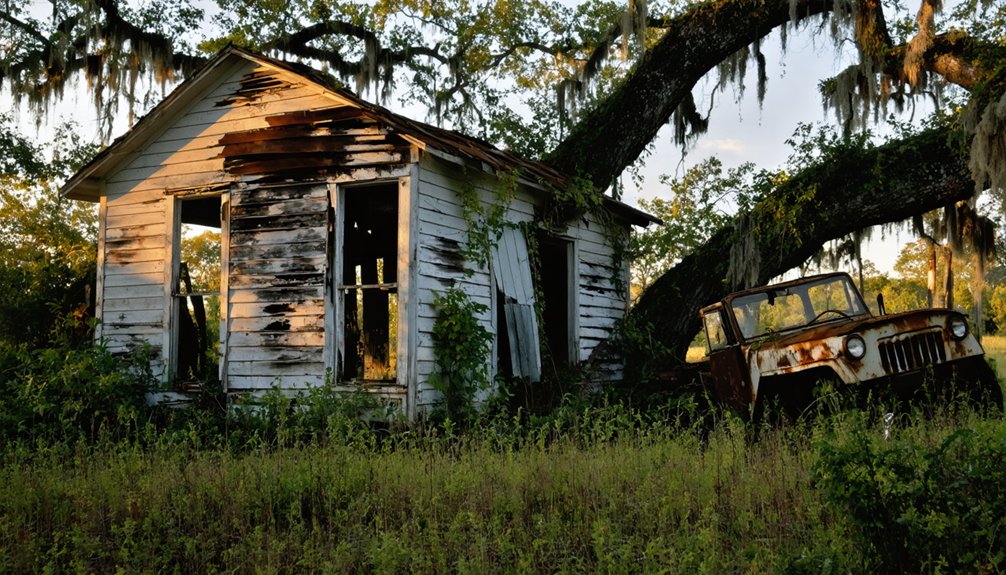You’ll discover East Krotz Springs’ fascinating history as a lumber mill town founded by Charles William Krotz in the early 1900s. Originally named Latania, this once-bustling community thrived on longleaf pine production from its 20,000-acre woodland and the marketing of artesian spring water. After devastating levee breaks in 1912 and 1913, followed by economic hardships, the town slowly declined. Today, it rests beneath the waters of Louisiana’s Atchafalaya National Wildlife Refuge, its story echoing the fate of many floodplain settlements.
Key Takeaways
- East Krotz Springs, originally named Latania, is now completely submerged within the Atchafalaya National Wildlife Refuge.
- The town vanished after devastating levee breaks in 1912 and 1913, marking its transition to ghost town status.
- Founded by Charles William Krotz after discovering a natural spring, the town flourished briefly as a lumber mill community.
- By 1909, the settlement had 18-20 families centered around the sawmill and newly arrived railroad connection.
- No physical traces of East Krotz Springs remain today, though its history exemplifies the fate of flood-vulnerable Mississippi Valley communities.
The Rise of a Lumber Mill Town
While Charles William Krotz initially sought oil in the dense woodlands of Louisiana, his discovery of a natural spring instead led to the establishment of East Krotz Springs, originally named Latania, at the turn of the 20th century.
Similar to Fullerton’s experience during the post-WWI era, the local mills experienced a surge in demand as lumber was needed for reconstruction efforts.
You’ll find the town’s roots deeply embedded in lumber production, as Krotz developed his 20,000-acre woodland into a thriving timber economy centered around valuable longleaf pine.
The area’s lumber operations continued well into the mid-1900s, with similar mills like the Crowell & Spencer facility operating until 1969 when timber resources became scarce.
Environmental Challenges and Natural Disasters
The transformation of East Krotz Springs from a lumber town to an industrial center brought significant environmental challenges that continue to shape the region today.
You’ll find the Delek refinery’s benzene emissions exceeding EPA standards by three times, creating environmental pollution that disproportionately affects minority and low-income residents.
Located in Cancer Alley, this area faces elevated cancer risks and respiratory illnesses due to the concentration of petrochemical facilities.
The 2020 data shows Delek’s emissions increased by 29% compared to the previous year, further worsening air quality concerns in the area.
The region’s water systems face multiple threats, with mercury contamination triggering fish advisories and poor water quality in Bayou Teche and Bayou Vermilion.
While the Teche-Vermilion Freshwater Project attempts to mitigate these issues, health disparities persist.
The 1927 flood’s aftermath led to levee construction that, while protecting urban areas, disrupted natural water flows and ecosystems.
These changes continue to impact water quality and expose vulnerable populations to industrial hazards.
The Legacy of Economic Decline
Since the Great Depression swept through Louisiana, East Krotz Springs has grappled with recurring economic setbacks that reshaped its industrial landscape. The town’s economic resilience was tested as local industries, from logging to oil exploration, experienced significant downturns. Like many rural communities in Louisiana during the Depression, the town saw cotton prices plummet to devastating levels. By 1933, the area faced severe hardships as the gross national product fell to less than half of its 1929 peak.
You’ll find evidence of community adaptation through the years, though the impact remains visible today.
Key factors in East Krotz Springs’ economic transformation:
East Krotz Springs faced major economic shifts, transforming from resource-based industries toward a more diversified but challenging economic landscape.
- Decline of traditional resource extraction industries, particularly logging and sawmilling operations
- Reduced agricultural activity in surrounding areas, affecting local trade and commerce
- Shifts in regional transportation patterns following the construction of the Krotz Springs Bridge
- Varying success of industrial diversification efforts, including oil exploration initiatives
Despite infrastructure improvements and periodic industrial investments, the area’s economic challenges have left lasting imprints on its development and population patterns.
Life in Early 20th Century East Krotz Springs
Life in early 20th century East Krotz Springs emerged from Colonel Charles W. Krotz‘s purchase of 20,000 acres in the Atchafalaya Basin. You’d have found a tight-knit community of 18-20 families by 1909, where community dynamics centered around the sawmill and artesian springs that Krotz discovered while drilling for oil. Krotz promoted the town’s growth by selling lots for $100 to $200 to new residents.
The settlement, initially called Latania, quickly developed its educational foundations. You would’ve seen children first attending a modest one-room schoolhouse, which later evolved into a substantial two-story brick building in 1916, funded by $12,000 in bonds.
The railroad’s arrival in 1909 transformed daily life, connecting you to broader markets and opportunities. You’d have witnessed the French and French-Canadian families establishing deep roots through the St. Anthony Catholic Church Cemetery and shared community spaces. The town’s economy grew through Krotz Springs Mineral Water Company, which marketed the artesian water’s health benefits to eager customers.
Remnants and Historical Significance Today
While searching for East Krotz Springs today, you’d find no trace of the once-thriving lumber community, as its entire footprint now lies submerged within the Atchafalaya National Wildlife Refuge at coordinates 30°32’54″N 91°44’45″W.
Originally known as Latania, the settlement underwent several transformations before its eventual abandonment. The town experienced devastating levee breaks in both 1912 and 1913, foreshadowing its ultimate fate.
The town’s transformation into a ghost town serves as a powerful reminder of nature’s dominance over human settlement.
Though physical remnants have vanished, the cultural memory lives on through:
- Historical accounts documenting its role as a vital lumber industry hub
- Regional ghost town compilations highlighting Louisiana’s transient settlements
- Educational case studies demonstrating environmental impacts on communities
- Local stories passed down about the devastating floods of 1927, 1973, and 2011
Unlike its surviving namesake across the river, East Krotz Springs exemplifies the vulnerability of floodplain communities in the Lower Mississippi Valley.
Frequently Asked Questions
Were There Any Documented Crimes or Notable Incidents in East Krotz Springs?
You won’t find documented crimes or notable incidents, despite any unsolved mysteries or local folklore. Natural disasters like floods and hurricanes shaped the town’s decline, not human conflicts.
What Happened to the Residents After They Left East Krotz Springs?
You’ll find most residents scattered to nearby towns like Krotz Springs and Morganza after the floods, though their exact fates remain largely undocumented due to the unplanned, individual nature of their relocation.
Are There Any Surviving Photographs of East Krotz Springs?
You won’t find any confirmed surviving photographs of this ghost town. Historical archives haven’t yielded any verified images, though flooding and natural erosion likely destroyed any photographic evidence that once existed.
Did Any Famous People or Notable Figures Visit East Krotz Springs?
You won’t find any famous visitors or notable residents in historical records – no celebrities, no dignitaries, and no distinguished guests ever documented visiting this remote lumber mill town.
What Was the Peak Population of East Krotz Springs?
You’ll find it difficult to pinpoint an exact peak population for this ghost town, but it likely mirrored nearby Krotz Springs’ zenith of 1,435 in 1970 before experiencing significant population decline.
References
- https://raregoldnuggets.com/?p=3886
- https://krotzsprings.org/town-history
- https://www.shreveporttimes.com/story/news/2025/09/04/does-louisiana-have-any-ghost-towns-how-many-are-there-where-to-find-abandoned-towns/85972403007/
- https://www.kssportsmensheritagefestival.com/about
- http://wikimapia.org/37768839/East-Krotz-Springs-Latania-Louisiana-Ghost-Town
- https://en.wikipedia.org/wiki/List_of_ghost_towns_in_Louisiana
- https://k945.com/these-3-louisiana-ghost-towns-are-just-a-road-trip-away/
- https://forestheritagemuseum.org/long-leaf-mill/sawmill
- https://heartoflouisiana.com/louisiana-sawmill-towns-short-life/
- https://en.wikipedia.org/wiki/Krotz_Springs



